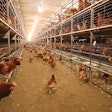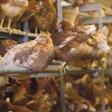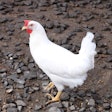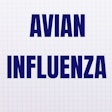Researchers at the University of Guelph (UG) in Guelph, Ontario, have created a portable tool to help predict outbreaks of avian influenza.
UG researchers devised a real-time way to analyze chickens and other farm birds for avian influenza. The tool uses a small blood sample and relies on a simple chemical color change to see not only whether a chicken has avian influenza but also what viral strain is involved.
Current tests require samples to be sent to a lab, where it can take eight hours to a couple of days to yield results. That’s too long, said the university’s Prof. Suresh Neethirajan, School of Engineering.
“Treatment, especially when dealing with humans who have been infected, needs to start as soon as possible,” he said.
“This test only needs two to three minutes to incubate, and then you get the results immediately. Not only that, but it is more cost-effective. Conventional techniques are time-consuming and labor-intensive, and require special facilities and expensive laboratory instruments.”
A study about the device will appear in an upcoming issue of the scientific journal Sensors, published by Molecular Diversity Preservation International (MDPI).
Earlier in April, Canadian officials placed eight farms in southern Ontario under quarantine after an avian influenza outbreak broke out in a commercial turkey operation near Woodstock, Ontario.
Preliminary testing on the strain was conducted at UG’s Animal Health Lab.
An outbreak of avian influenza also took place in British Columbia in January and December of 2014. South of the border, 15 states have had confirmed cases of avian influenza.
Scientific knowledge not needed to use tool
Neethirajan and post-doctoral researcher Longyan Chen wanted to create a test that could be used by anyone, even a non-scientist.
“That is why we designed it so that the final color changes based on what type of influenza it is, and it can differentiate between a human strain and a bird strain,” said Neethirajan.
“It’s critical to get out front of any outbreaks. There are many strains, and we need to know the source of the flu. The identification of the strain determines what treatment options we should use.”
How the tool works
The device uses gold nanoparticles (microscopic particles) and glowing quantum dots. The researchers developed a novel approach for rapid and sensitive detection of surface proteins of viruses from blood samples of turkeys.
The new nanobiosensor can detect the strains of H5N1 and H1N1. The most recent outbreak was from H5N2, which is similar to H5N1, Neethirajan said. With some architecture modifications, the developed biosensing technique has the potential to detect the H5N2 strain as well, he said.
The subtype H1N1 is human adapted while most H5 are avian oriented, Neethirajan added.
“We’re creating a rapid animal health diagnostic tool that needs less volume of blood, less chemicals and less time. We will be able to determine, almost immediately, the difference between virus sub-strains from human and avian influenza.”



.jpg?auto=format%2Ccompress&fit=crop&h=167&q=70&w=250)












